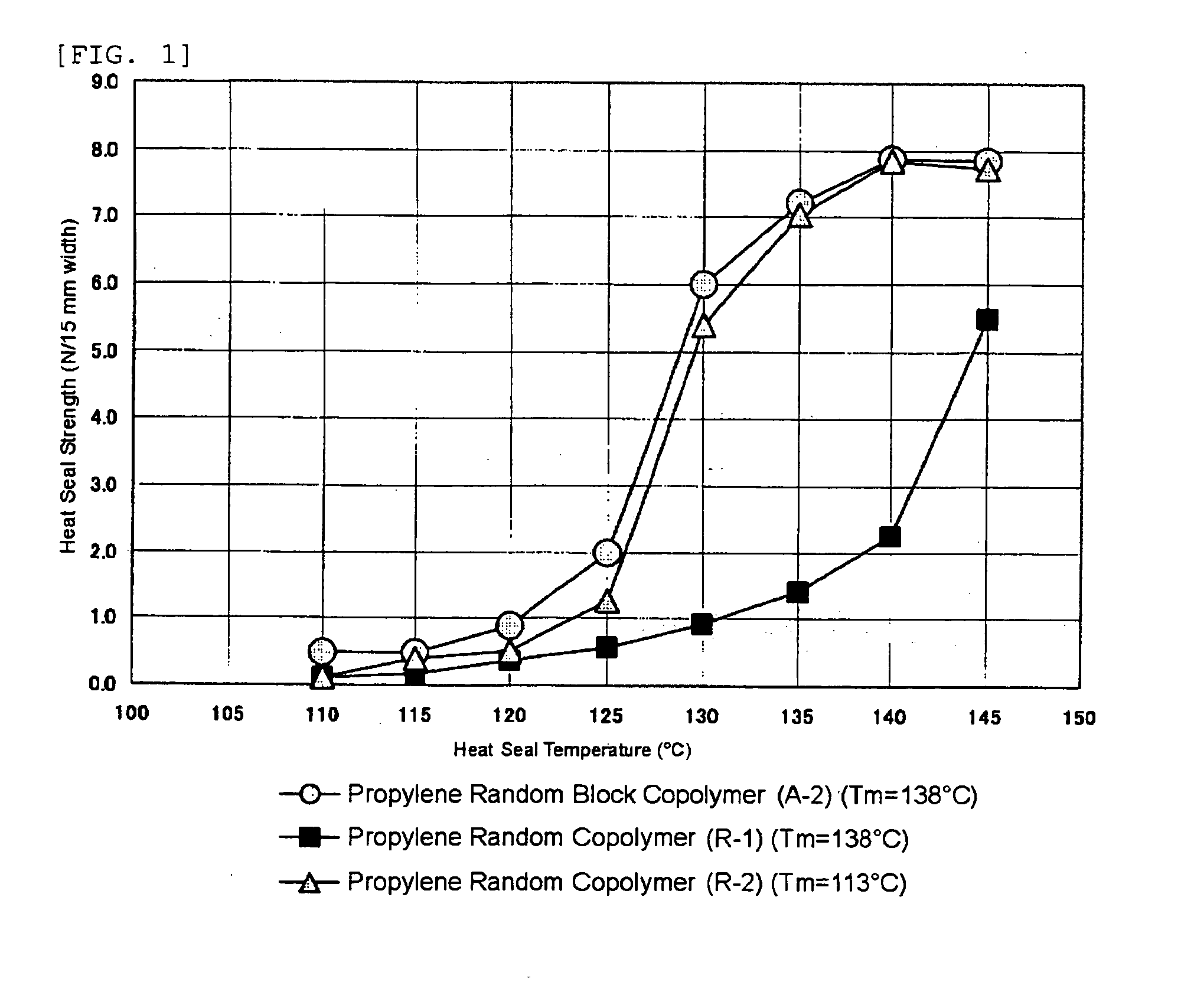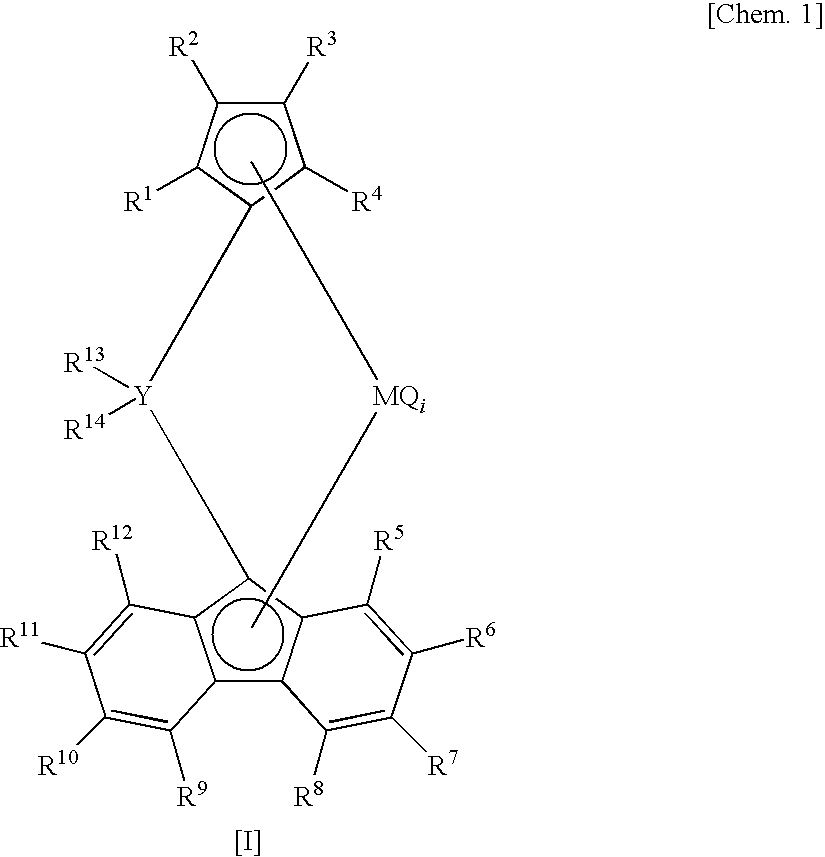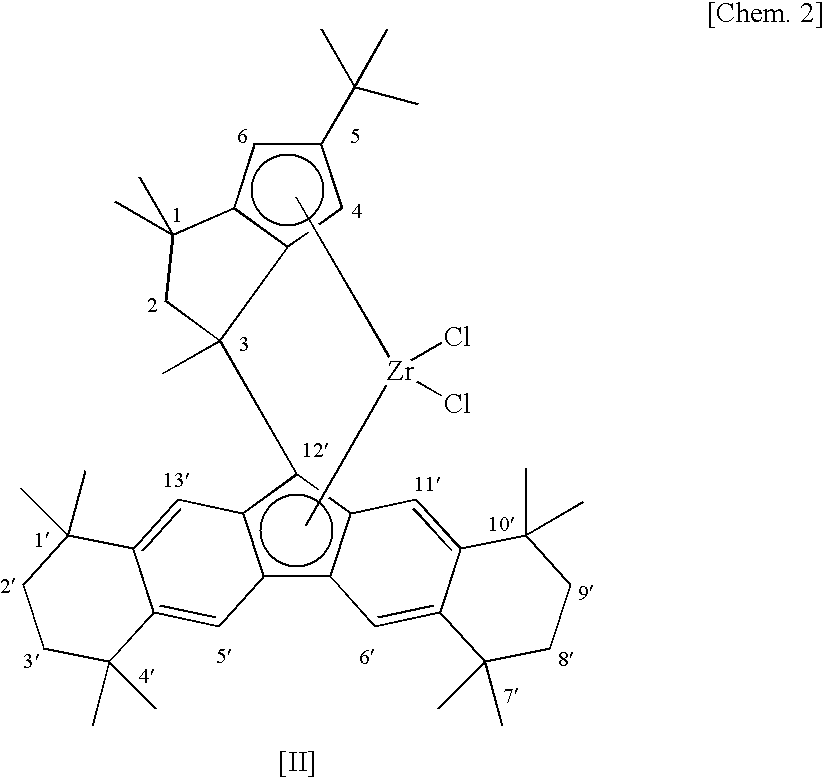Propylene Random Block Copolymer, Resin Composition Containing the Copolymer and Molded Article Made Thereof
a random block and polypropylene technology, applied in the field of polypropylene resin composition containing the copolymer and a molded article formed thereof, can solve the problems of poor impact resistance, slow solidification speed during film formation, and deterioration of rigidity of the film, and achieve excellent heat resistance, transparency and impact resistance. , the effect of improving the filming properties
- Summary
- Abstract
- Description
- Claims
- Application Information
AI Technical Summary
Benefits of technology
Problems solved by technology
Method used
Image
Examples
production example 1
(1) Production of Solid Catalyst Carrier
[0174]In a 1 L branched flask, 300 g of SiO2 was sampled and 800 ml of toluene was added to prepare a slurry.
[0175]In the next place, the slurry was transferred into a 5 L 4-neck flask, and 260 ml of toluene was added.
[0176]2830 ml of a methylaluminoxane (hereinafter referred to as MAO)-toluene solution (10% by weight solution, produced by Albemar Co., Ltd.) was added thereto, and the mixture was agitated at room temperature for 30 min, heated to 110° C. over 1 hr and allowed to react for 4 hr. After completion of the reaction, the mixture was cooled to room temperature. After the cooling, supernatant toluene was removed and fresh toluene was substituted for it until the degree of substitution was 95%.
(2) Production of Solid Catalyst Component (Supporting a Metal Catalyst Component on the Carrier)
[0177]In a glove box, 2.0 g of diphenylmethylene(3-t-butyl-5-methylcyclopentadienyl)(2,7-di-t-butylfluorenyl)zirconium dichloride (M1) synthesized ac...
production example 2
[0187]Except that a polymerization method was changed as shown below, a method similar to that of Production Example 1 was carried out.
[0188](1) Polymerization
[0189]In a 58 L tubular polymerization equipment, propylene was continuously fed at 40 kg / hr; hydrogen at 5 N L / hr; the catalyst slurry prepared in the (3) of Production Example 1 at 3.6 g / hr in terms of the solid catalyst component; and triethyl aluminum at 2.2 g / hr, and the mixture was subjected to polymerization in a full liquid state where no gaseous phase existed in the tubular polymerization equipment. The temperature in the tubular reactor was set at 30° C. and pressure was set at 3.2 MPa / G. The catalyst in the reaction is referred to as M1 catalyst.
[0190]The resulting slurry was delivered to a 1000 L vessel polymerization equipment equipped with an agitator, and further subjected to polymerization. To the polymerization equipment, propylene was fed at 45 kg / hr, ethylene was fed so that the ethylene concentration in the...
production example 3
[0195]Except that a polymerization method was changed as shown below, a method similar to that of Production Example 1 was carried out.
[0196](1) Polymerization
[0197]In a 58 L tubular polymerization equipment, propylene was continuously fed at 40 kg / hr; hydrogen at 5 N L / hr; the catalyst slurry prepared in the (3) of Production Example 1 at 3.6 g / hr in terms of the solid catalyst component; and triethyl aluminum at 2.2 g / hr, and the mixture was subjected to polymerization in a full liquid state where no gaseous phase existed. The temperature in the tubular reactor was set at 30° C. and pressure was set at 3.2 MPa / G. The catalyst in the reaction is referred to as M1 catalyst.
[0198]The resulting slurry was delivered to a 1000 L vessel polymerization equipment equipped with an agitator, and further subjected to polymerization. To the polymerization equipment, propylene was fed at 45 kg / hr, ethylene was fed so that the ethylene concentration in the gaseous phase portion would be 1.5% by ...
PUM
| Property | Measurement | Unit |
|---|---|---|
| Temperature | aaaaa | aaaaa |
| Temperature | aaaaa | aaaaa |
| Fraction | aaaaa | aaaaa |
Abstract
Description
Claims
Application Information
 Login to View More
Login to View More - R&D
- Intellectual Property
- Life Sciences
- Materials
- Tech Scout
- Unparalleled Data Quality
- Higher Quality Content
- 60% Fewer Hallucinations
Browse by: Latest US Patents, China's latest patents, Technical Efficacy Thesaurus, Application Domain, Technology Topic, Popular Technical Reports.
© 2025 PatSnap. All rights reserved.Legal|Privacy policy|Modern Slavery Act Transparency Statement|Sitemap|About US| Contact US: help@patsnap.com



